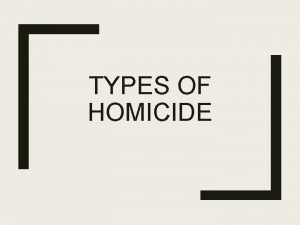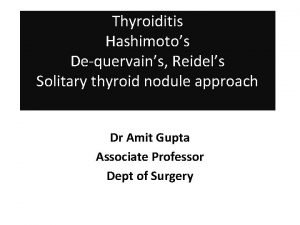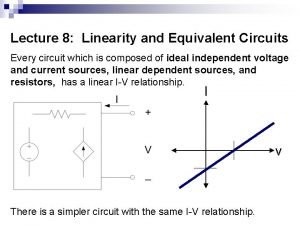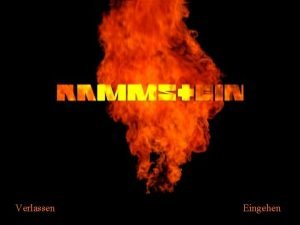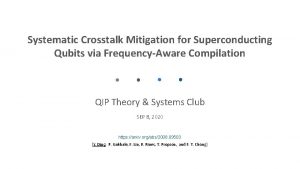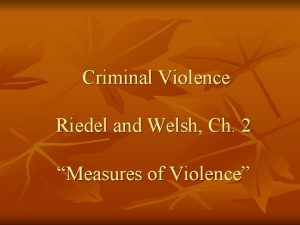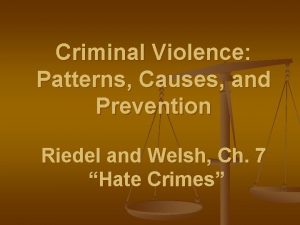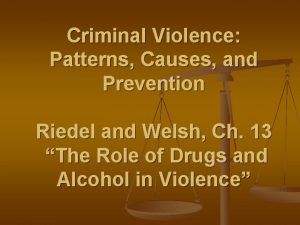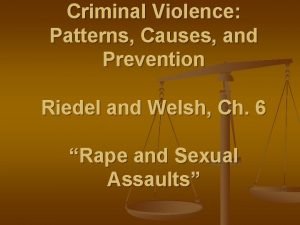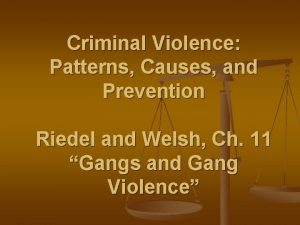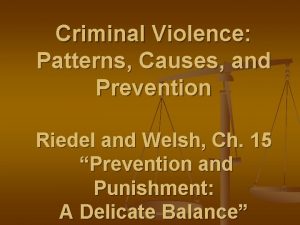Criminal Violence Riedel and Welsh Ch 4 Homicides


















- Slides: 18

Criminal Violence Riedel and Welsh, Ch. 4 “Homicides and Assaults”

OUTLINE Homicides and Assaults in the U. S. n Patterns and Trends n Explanations n Interventions

Definitions n n n Murder and Non-negligent Manslaughter (UCR): the “willful (non-negligent) killing of one human being by another. ” Aggravated Assault (NCVS): "attack or attempted attack with a weapon, regardless of whether an injury occurred or not, as well as an attack without a weapon when serious injury resulted". Simple Assault: does not involve a weapon; does not result in serious injury to the victim.

Homicide Patterns (UCR): 2008 VICTIMS Gender: 78% of victims were male Gender Race: 47. 8% of victims were black, 48. 2% white, 2. 3% Race “other. ” Victim/offender relationship: Victim/offender relationship n 12. 3% were murdered by strangers, n 17. 5% of victims were killed by intimate partners or other family members, n 26% slain by friends or acquaintances OFFENDERS Gender: 65% of offenders were males. Race: 36. 5% of offenders were black, 32. 8% white INCIDENTS Firearms : Firearms 66. 8% of the offenses involved firearms. Setting: 28. 9% of victims were murdered during brawls or arguments

• The homicide rate doubled from 4. 6 per 100, 000 U. S. residents in 1962 to 9. 7 per 100, 000 by 1979. • In 1980 the rate peaked at 10. 2 per 100, 000 and fell to 7. 9 per 100, 000 in 1984. • The rate rose again in the late 1980 s and early 1990 s to another peak in 1991 of 9. 8 per 100, 000. • The homicide rate declined sharply from 9. 3 homicides per 100, 000 in 1992 to 4. 8 homicides per 100, 000 in 2010.

NCVS Assault Rates, 1993 - 2013 Simple Assault Aggravated Assault rates have declined since 1993.

Patterns: Assault For aggravated assault, men are victimized at higher rates than women, and blacks are victimized at higher rates than whites. For simple assault, these differences nearly disappear.

Patterns: Assault Victims knew the offenders in 40% of violent crimes against men and 64% of violent crimes against women in 2010.

Explanations n Symbolic interaction theory n Both homicides & aggravated assaults tend to result from an escalation of interpersonal conflict [see Luckenbill]. n Both tend to have similar situational dynamics: Both tend to occur between people who know one another, especially during an argument or fight. n Violence is often goal-oriented behavior: "to compel or deter others, to achieve a favorable social identity, and to obtain justice, as defined by the actor. " n

Explanations (cont. ) n Subcultural theories: values and beliefs that sanction violence as problem-solving behavior within certain groups (e. g. , gangs).

Interventions Q: What explanations have been offered for declines in homicide and aggravated assaults since 1993? 1. 2. 3. 4. 5. 6. 7. Decline in high-risk age group (15 -24); Decline in handgun homicide; Drug markets stabilized; Increase in legitimate and decrease in illegitimate opportunities; Increased use of incarceration; Decline in partner homicides; Violence prevention programs (e. g. , mediation).

Serial Homicides and Mass Murders Serial homicide: multiple killings by the same person over a period of time, usually months or years n Mass murder: single event or several killings in a very brief period-- “spree killing. ” n

Mass Murders: Patterns A number of characteristics distinguish mass from serial homicides or murders.

Mass Murders Virginia Tech Shootings n https: //www. youtube. com/watch? v=v. BG 7 z. HDc 8 -A Colorado Shootings n n http: //www. hulu. com/watch/383558 http: //www. cnn. com/2015/01/20/us/colorado-james-holmes-trial-moviemassacre/ Discussion: 1. What are some of the major causes (explanations) of mass murders such as these? Give specific examples from Ch. 4 and other course materials to support your answer.

Serial Homicides n n Prior to 1980 s, inflated estimates resulted Prior to 1980 s, from invalid practice of attributing all homicides with “unknown” circumstances to serial killings. FBI Estimates: about 127 serial homicide victims/year (< 1% of all homicides); about 10 offenders operating at any one time. Psychological appearance: “extraordinarily ordinary. ” Fox & Levin: serial killers kill for thrills, sexual satisfaction, or feelings of dominance and control-- more “cruel” than “crazy. ” Some are sociopaths, but show affection toward family members & friends.

Serial Homicides: Patterns n n n Victims: often vulnerable (e. g. , elderly, transients, prostitutes, runaways, hospital patients) people who may not be quickly missed. Offenders: Hickey identified 337 males (83%) and 67 female serial killers (17%) responsible for 2, 526 homicides between 1800 -1995. n Whites: 80% of all serial killers. n Majority tend to operate in one city or even one neighborhood. Trends: may have increased over time. n 35% of the killers in sample were identified between 1950 -1974; n 45% of the killers in the sample were identified between 1975 -1995.

Explanations Little research supports any one cause consistently. n Biological: XYY, neurotransmitters, hormonal imbalances. n Psychological: psychosis, dissociative disorders, personality disorders, psychopathy. n Sociological: anonymity and normlessness (anomie), child abuse, labeling, lack of social bonds. n But: huge number of “false positives” (i. e. , many normal people have one or more of these characteristics and are not killers, or even violent, or even criminals). Interventions n Law enforcement approaches: interagency communication, geographic analysis (e. g. , DC Snipers), DNA analysis, and profiling (look for patterns in incidents, victims, places).

Possible Explanations: Examples P = Person (e. g. , biological factors) n n Genes: (e. g. , low MAOA; XYY) Brain functioning (e. g. , low prefrontal activity, heightened limbic activity) E = Environment (e. g. , developmental experiences) n Example: History of abuse, neglect, bullying C = Culture (e. g. , values and norms) n Values about what is appropriate behavior (or not) P X E X C = Interactions between these factors n Example: MAOA gene doesn’t increase aggression unless combined with history of abuse
 Types of homicides
Types of homicides Tuba city unified school district
Tuba city unified school district Electric circuits nilsson
Electric circuits nilsson Reidels
Reidels Jessica dzem
Jessica dzem Ryszard riedel wikipedia
Ryszard riedel wikipedia Marcel riedel
Marcel riedel Riedel frota
Riedel frota Klaus riedel
Klaus riedel Every circuit
Every circuit Mexikaner ramstein
Mexikaner ramstein Theran riedel
Theran riedel Goodbye alun lewis analysis
Goodbye alun lewis analysis 20 in welsh
20 in welsh Welsh national anthem in english
Welsh national anthem in english Welsh powell
Welsh powell Welsh ghost stories
Welsh ghost stories Rules of snooker
Rules of snooker Renate welsh wohnort
Renate welsh wohnort
